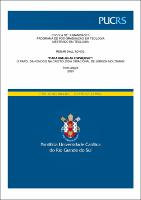| Share record |


|
Please use this identifier to cite or link to this item:
https://tede2.pucrs.br/tede2/handle/tede/11075| Document type: | Dissertação |
| Title: | “Para um lugar espaçoso” : o papel da kénosis na cristologia criacional de Jürgen Moltmann |
| Author: | Dall’Agnol, Renan  |
| Advisor: | Pich, Roberto Hofmeister |
| Abstract (native): | Esta pesquisa reflete sobre o papel da kénosis na cristologia criacional de Jürgen Moltmann, onde se destaca a chamada amplitude espacial. A teologia moderna rejeitou o estudo do espaço e acatou-o como exclusivo das ciências naturais. No entanto, a salvação e seus frutos, como justiça, paz, vida plena e cuidado ecológico, não surgem em uma realidade antiespacial. Logo, pretende-se transformar a visão que dissocia os conceitos do agir humano e, com isso, expressar a importante colaboração da espacialidade teológica na esperança de um éthos transformador. Esta dissertação se concentra na área sistemática sem perder de vista o horizonte social. Através do método hermenêutico e de uma sucinta referência aos alicerces do edifício moltmanniano, apresenta-se o fundamento do espaço vital, proporcionado por Deus à sua criação e a promessa de shekináh cósmica. Moltmann demove a concepção moderna que reduz a Trindade ao sujeito absoluto, aprofunda a teologia da criação e a escatologia e as elucida com a noção veterotestamentária de in-habitação (capítulo 1). A partir da doutrina trinitária e por meio da premissa de abertura, discorre-se sobre o esvaziamento kenótico como um fundamento cosmológico plausível. No fim paradoxal de Jesus Cristo – o Abandonado ao nada absoluto – na cruz, emergem o novo início espacial e as experiências salvíficas do processo criacional atual (capítulo 2). Acena-se para a relação entre ciência e criação, indaga-se sobre a alegada apropriação do espaço por parte das modernas ciências naturais e propõe-se a busca de um espaço integrador e um agir sapiencial entre as áreas de conhecimento. A seguir, descreve-se a dimensão espacial no contexto da nova criação gerada pelo Ressuscitado, explicita-se o que o teólogo entende por cristologia cosmológica e como ela cria um éthos transformador na criação corrente (capítulo 3). Em síntese, neste lugar dissertativo enfatiza-se o espaço amplo, experienciado pelo ser humano, e a vitalidade suscitada por Deus em cada criatura. Pretende-se ajudar na mudança das presentes iniquidades – guerra, migração, crise ecológica, etc. – ressaltando a kénosis divina como o início da escatológica transfiguração criacional. |
| Abstract (english): | This research inquiries into the role of kenosis in Jürgen Moltmann's creational Christology, where the spatial amplitude is emphasized. Modern theology rejected the spatial study and heeded it exclusive to the natural sciences. However, salvation and its fruits, as justice, peace, a fulfilling life and an ecological care, don’t emerge from and anti-spatial reality. Therefore, it is intended to transform the vision that disassociates the concepts of human behavior and, with this, express the important collaboration of theological spatiality hoping for a transforming ethos. This dissertation concentrates on the systematic subject, without losing sight of the social horizon. By means of the hermeneutic method and a short reference to the foundations of the Moltmannian’s building, it is presented the basis of the living space, provided by God to its creation and the promise of a cosmic shekinah. Moltmann removes the modern conception that reduces the Trinity to the absolute subject, goes further into the creation theology and eschatology and elucidates them with an Old Testament’s indwelling notion (chapter 1). From the trinity doctrine and throughout the opening premise, the kenotic self-restriction as a plausible cosmological fundament is discussed. At the paradoxical end of Jesus Christ – the Abandoned to the absolute nothingness – at the cross, the new spatial beginning and the redemptive experiences of the current creational process emerge (chapter 2). A nod is given to the relation between science and creation, the alleged appropriation of space by the modern natural sciences is inquired and the search for an integrative space and a sapiential behavior between the knowledge areas is proposed. Following, the spatial dimension on the context of the new creation generated by the Resurrected is described, the theologian understanding of cosmological Christology and how it creates a transforming ethos on the current creation is clarified (chapter 3). Summarizing, at this discursive space the broad space, experienced by the human being, and the vitality aroused by God in each creature is emphasized. It is intended to help change the present iniquities – war, migration, ecological crisis, etc. – reinforcing the divine kenosis as the beginning of the eschatological creational transfiguration. |
| Keywords: | Espaço Kénosis Criação Jürgen Moltmann Teologia Space Kenosis Creation Jürgen Moltmann Theology |
| CNPQ Knowledge Areas: | CIENCIAS HUMANAS::TEOLOGIA |
| Language: | por |
| Country: | Brasil |
| Publisher: | Pontifícia Universidade Católica do Rio Grande do Sul |
| Institution Acronym: | PUCRS |
| Department: | Escola de Humanidades |
| Program: | Programa de Pós-Graduação em Teologia |
| Access type: | Acesso Aberto |
| Fulltext access restriction: | Trabalho não apresenta restrição para publicação |
| URI: | https://tede2.pucrs.br/tede2/handle/tede/11075 |
| Issue Date: | 31-Aug-2023 |
| Appears in Collections: | Programa de Pós-Graduação em Teologia |
Files in This Item:
| File | Description | Size | Format | |
|---|---|---|---|---|
| Renan_Dallagnol_DIS.pdf | RENAN_DALL’AGNOL_DIS | 1.33 MB | Adobe PDF |  Download/Open Preview |
Items in DSpace are protected by copyright, with all rights reserved, unless otherwise indicated.




